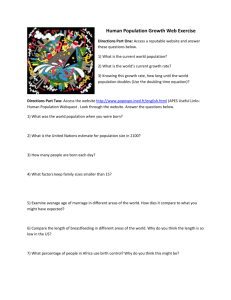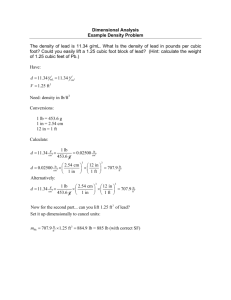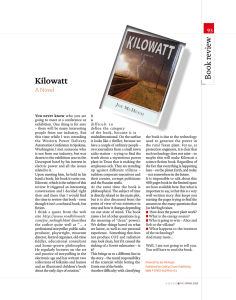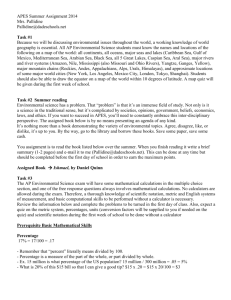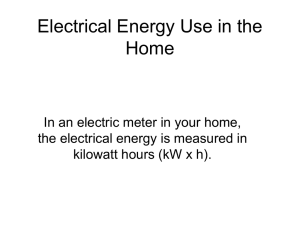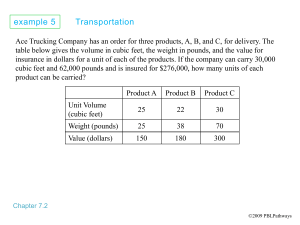APES Math and Equation Review
advertisement
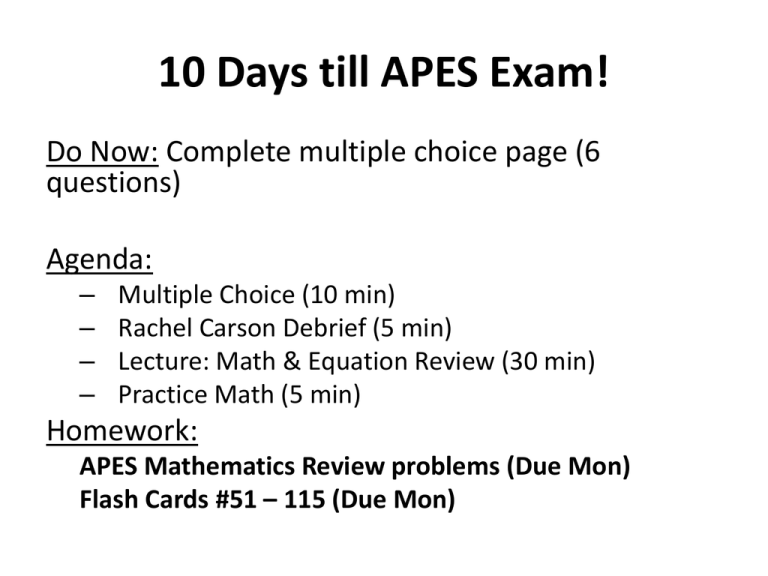
10 Days till APES Exam! Do Now: Complete multiple choice page (6 questions) Agenda: – – – – Multiple Choice (10 min) Rachel Carson Debrief (5 min) Lecture: Math & Equation Review (30 min) Practice Math (5 min) Homework: APES Mathematics Review problems (Due Mon) Flash Cards #51 – 115 (Due Mon) Duckweed Lichens Elodea APES Math and Equation Review • 1) Show all work. No work, no credit. This is critically important for every calculation, even if it seems trivial. • 2) Show all units. Units provide valuable information. • 3) Develop good “math sense” or “math literacy.” The answers should make sense. If you calculate a cost of $50 billion per gallon of water, does this seem right? • 4) Know simple conversion factors such as the number of days in a year or hours in a day. Other good numbers to know: • U.S. population = approx. 320 million (320,000,000 or 3 x 108) • World population = approx. 7 billion (7,000,000,000 or 7 x 109) • 5) Know and convert metric prefixes. – – – – – – – – – – – T tera- 1012 (trillion 1,000,000,000,000) G giga- 109 (billion 1,000,000,000) M mega- 106 (million 1,000,000) k kilo- 103 (1000) h hecto- 102 (100) da deka- 101 (10) d deci- 10-1 (0.1) c centi- 10-2 (0.01) m milli- 10-3 (0.001) μ micro- 10-6 (one-millionth 0.000001) n nano- 10-9 (one-billionth 0.000000001) -6 • 6) Be comfortable working with negative numbers. Going from -8oC to +2oC is a ________ • 10oC change. • 7) Use dimensional analysis. Conversions should show units of measurement and conversion factors. • Example: If water has a density of 62 pounds per cubic foot, how many tons of water are contained in a 4000 cubic foot tank? • 4000 cubic foot tank x ___________________ • x (62 pounds/cubic foot) x (1 ton/2000 pounds) = 124 tons • Example: If electricity costs $0.20 per kilowatt hour, calculate the cost to run a 1500 watt appliance for two hours. • 1500 watts x (1 kilowatt/1000 watts) x 2 hours x ($0.20/kilowatt hour) = $0.60 • 8) Work scientific notation problems without a calculator. Multiplication and division will be common. Multiplying numbers in scientific notation requires the exponents to be added. Dividing numbers in scientific notation requires exponents to be subtracted. • Examples: 106 TIMES 103 = • 109 • 108 DIVIDED BY 101 = • 107 • 9) Calculate percent change. Percent change can be calculated by finding the difference between the old and new values, and then dividing by the old value. Convert to a percent by multiplying by 100. • Example: old value = $400, new value = $500, percent change = • ($100/$400)x 100 = 25% increase • 10) Calculate population growth rate and population density. • Growth rate = [b - d] + [i - e] • Population density = population divided by area • Example: A village of 24,00 people has 2,000 births and 500 deaths. What is the growth rate for this village? Express as a percentage. • r = (2,000-500) / (2,000) x 100% = 75% • 11) Know the Rule of 70 to predict doubling time. • Doubling time = 70 divided by annual growth rate (in %) • Example: If a country were doubling its population every 35 years, what would its growth rate be? • DT = 70/r • 35 = 70/r • r = 70/35= 2% • 12) Calculate half-life. • AMOUNT REMAINING = (ORIGINAL AMOUNT)(0.5)x, where x = number of half-lives • 13) Calculate pH using –log [H+]. Log10 x = y and 10y = x. • Most pH problems are easily solved without a calculator. Remember that for every one-increment change in pH, the ion concentrations change by a factor of 10. • Examples: if pH = 6, then the concentration of hydrogen ions [H+] = 1 x 10-6 • If pH = 2, then the concentration of hydrogen ions [H+] = 1 x 10-2 • If the concentration of hydrogen ions = 1 x 10-13, then the pH = 13 14) Be familiar with units of energy and power. • Watt = joule/sec = volts x amps • Calorie = energy to raise one gram of water by one degree C. • BTU (British thermal unit) = energy to raise one pound of water by one degree F. • Kilowatts x hours = kilowatt hours • Efficiency = energy out divided by energy in • Example: How much energy, in joules, does a 60Watt light bulb use then it is turned on for 10 minutes? • 60 W = 60 J/sec • (60 J/sec) (60 sec/min)(10 min)= 360 J • 15) AP GRAPHING TIPS • Label each axis. • Set both axes to scale with consistent increments. • Connect dots. • Interpolate and extrapolate. • Be comfortable with doing graphs by hand. • Include a title and a key.
